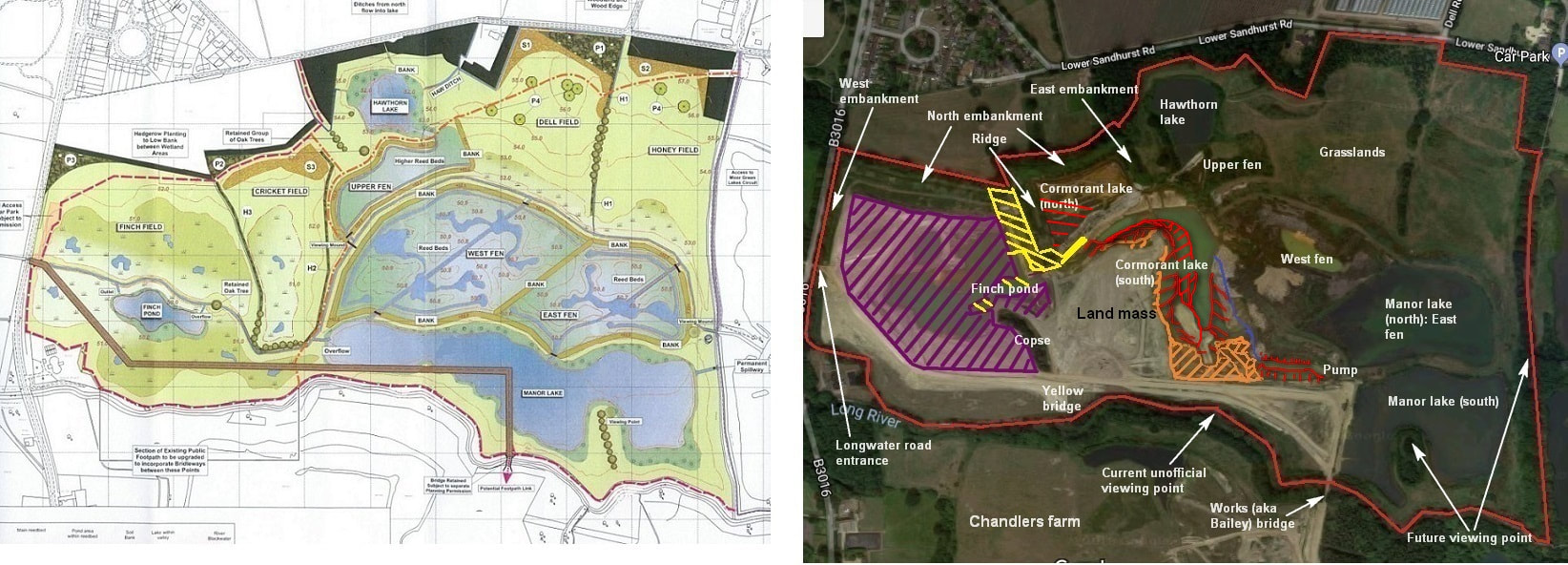|
Title says it all really. I managed to get to Manor farm on Thursday. It rained all day Wednesday. I spotted one lorry on the land mass when I arrived. I didn't see any other lorry by the time I left 25 minutes later. It could have been tea break, but I am not sure. Our bulldozer driver was trundling all over the land mass. He had flattened the new mound built last week. Saturday morning was dull, overcast, but reasonably mild. I got quite a few surprises on my stomp, beginning along the south vehicle path. Finch pond is now quite drained. This is due to Inter opening up the land bridge, turning it into a drainage channel again. I was thwarted in my efforts to get to the ridge and Cormorant lake (north). Inert have been working all over the land mass, despite the lack of lorry traffic on Thursday. What they have been up to is a little difficult to discern, especially between the copse and my mighty mound, along the south vehicle track. Lots of dozer and lorry tracks. Lots of churned up ground. Some areas where soil had been dumped. But nothing obvious. Moving on to the land mass, and walking up to the northern and west shores of Cormorant lake (south), well as close as I dared as the ground was getting quite boggy the close I got to water, it was obvious that Inert have been pushing large quantities of spoil into said lake. However, pace appears to have slowed considerably. They have also made further onslaughts onto the scrape. It is now over 60% covered. Again, strange decision to build it, infill around it, only to obliterate it. I didn't walk over to the pump, and so couldn't see if it was working. I did hear it chugging away on Thursday. Whilst the ground conditions are still quite firm across the land mass, I fear today's downpour, and further rain forecasts for next week, could cause a deterioration in ground conditions, slowing work even further. Before the slide show. My crude map, updated to show how far the restoration has come. The latest bit is the north east part of the land mass. The big news, as the headline says, is that this could be the end of our scrape. This has been a feature for years, appearing and disappearing as water levels drop and rise, added to by Inert with large quantities of sand last year, and very popular with the birds. Inert themselves have been infilling around the scrape, up to now, taking great care not to encroach on it. This strategy appears to have changed, with Inert pushing a large amount of spoil onto the north end of the scrape. Does this signal its demise? Well, quite probably, as I have been hinting over the past couple of years. I've seen Inert do similar actions before. They go to great pains to build structures - normally mounds of spoil - before flattening them. I did hope the scrape would survive (it may yet) as it has proved very popular with bird life. Other news. Water levels have dropped dramatically due, I suspect, to the pump being turned on. I say suspect, as I believe I heard it chugging away, but didn't wander over to verify - I was a bit pushed for time. It's the only way I can see water levels dropping this fast. Anyway, the receding water meant that the land bridge was now quite exposed. I crossed it, and found it very firm underfoot. Restoration appears to have slid to its normal sluggish pace. I might be unfair, but I have only seen a two or three lorries working on the site this past couple of weeks. Their numbers might have swelled during the considerable time I wasn't stomping around the south footpath. However, I doubt it, as progress has been markedly slow. Saying that, Inert appear to have concentrated on dumping more spoil onto the land mass; mostly the eastern side, encroaching on the scrape in the process. There are signs (i.e. fresh tracks) that Inert briefly flirted with a quick wander around what was Finch pond. Oh, I sank up to my knees in mud again. I was most surprised, as the ground was quite firm. I was trying to get around the west side of my mighty mound. I think I picked the one spot where the mud was very soft. To be honest, my only concerns were either getting absolutely filthy if I had to lie down to haul my wellies out of the mud or the ignominy of having to call out emergency services if I really got stuck - unlikely, but ya never know. The only reason I had to take a detour around my mighty mound was because there is this 'channel' that snakes from the west side of my mound, across the land mass, to the land bridge by the ridge. Thursday's stomp around the south footpath revealed considerable flooding on Manor farm due to storm Alex. The land bridge to Cormorant lake (north) was under water, as was the alternative route around the ridge. Finch pond has reappeared, over quite an extent, but will soon disappear. Inert were at play, on Thursday, though restricted to the middle south and east of the land mass. There didn't seem to be many lorries around. About three or four, from what I could make out during my brief foray. Saturday morning was bright, cold and frosty; a nice change from the deluges we've been experiencing. I was slightly disappointed to see that water levels, although still high, had fallen considerably since Thursday. This was perplexing to me, as the pump was not working on Thursday or Saturday or the week prior. I am puzzled as to how the water is draining from the site. Despite the flooding, ground conditions were very good; firm to hard in, I believe, horse racing parlance. This is a far cry from before lockdown. A combination of freshly bulldozed spoil and plenty of rain led to lethally soft soil; the consistency of quicksand in some places. Large areas of Manor farm, including vehicle tracks, were off limits to me, such was the depth of gooey mud. The soil had settled and compacted over the summer, enabling me to walk anywhere on Manor farm - apart from the flooded bits. Having not been for two weeks, I was intrigued to see what progress had been made by Inert. They appear to have made reasonable inroads into filling Cormorant lake (north) before storm Alex hit last week. It was a little difficult to gauge accurately as the area being filled was underwater, apart from a small spit, projecting into Cormorant lake (north). This spit marks the edge of where the bulldozer had got to as it pushes spoil into the lake. Inert were more or less forced to work on the middle part of Cormorant lake (south) or, as I call it, the land mass. Again, it was fairly difficult to gauge progress. I guess steady, is the operative word. I made the mistake of starting my stomp by walking along the west embankment. I got stung rotten by stinging nettles. They got me through my summer wear hiking trousers. I used the embankment as I thought the ground from Longwater road to the ridge would be soft and muddy (i.e. sink up to your knees type mud) as it was prior to lockdown. Not so. The ground was quite firm, even round the margins of the emergent Finch pond. There was masses of wildlife on site. Loads of Egyptian geese, Lapwing and Canada geese; who loved the large expanses of water. They seemed to prefer the emergent Finch pond, which is a reversal of what I have observed in previous years. I can only put it down to Finch pond now having lots of little islands poking out of it. There were the usual plethora of small brown birds. Somewhat busy mid-week, hence no stomp on Tues, Wed or Thurs. Far too wet over the weekend with slow moving storm Alex dropping a load on the UK.
However, whilst you are here why not register for the Covid-19 vaccine. I did, way back in June. |
AuthorA polite notice first: All photographs on this blog are owned by me and subject to copyright. Archives
November 2025
Categories |


 RSS Feed
RSS Feed